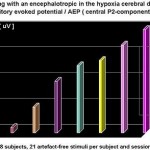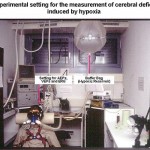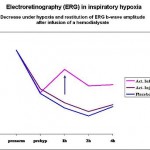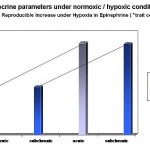Hypoxia & Dementia-Simulation by induction of cerebral deficit syndrome
Usefulness of the methods
The potential of a drug to improve the symptoms of dementia (cerebral deficit) has to be proven in patients. However, with multi-morbid patients – showing different spontaneous courses of their illness, fixing the effective dose range, elaborating the optimal dose (see improving dose-finding with Idebenone in AEPs under hypoxia vs. placebo and reference, left figure) and obtaining knowledge of the time-effect relationship of new drugs before starting the main clinical trials – is difficult, time consuming and costly. But these data are indispensable for a good clinical development programme.
elaborating the optimal dose (see improving dose-finding with Idebenone in AEPs under hypoxia vs. placebo and reference, left figure) and obtaining knowledge of the time-effect relationship of new drugs before starting the main clinical trials – is difficult, time consuming and costly. But these data are indispensable for a good clinical development programme.
Using simulation of dementia in healthy volunteers (induction of a global cerebral deficit syndrome by normobaric inspiratory hypoxia; for experimental set-up see fig. left) – as a system for drug testing early in the clinical development of an investigational drug – can provide this information at low cost in a very short time. Moreover, obtaining proof of concept data early may make considerable savings. Our methods can be run in parallel with the preparation of the clinical studies to allow incorporation of the feedback from our results. Our sensitive and predictive model has proven to be very suitable for this purpose.
– as a system for drug testing early in the clinical development of an investigational drug – can provide this information at low cost in a very short time. Moreover, obtaining proof of concept data early may make considerable savings. Our methods can be run in parallel with the preparation of the clinical studies to allow incorporation of the feedback from our results. Our sensitive and predictive model has proven to be very suitable for this purpose.
Principle of the methods
Induction of hypoxia as a model of dementia:
Volunteers inhale air with a reduced content of oxygen (10 % O2, 90 % N2, normobaric).  This results in a global functional cerebral deficit (“downregulation”, also in the retinal/glial originating ERG signal, e.g. the b-wave with improvement by an effective encephalotropic drug – see figure left) characterised by a decrease in vigilance and CNS performance similar to that observed in clinical dementia. These changes can be optimally measured with our test battery.
This results in a global functional cerebral deficit (“downregulation”, also in the retinal/glial originating ERG signal, e.g. the b-wave with improvement by an effective encephalotropic drug – see figure left) characterised by a decrease in vigilance and CNS performance similar to that observed in clinical dementia. These changes can be optimally measured with our test battery.
Concomitant – as in human dementia – there are also changes in vital signs during hypoxia (e.g. as heart rate, blood pressure, RMV etc.) and in humoral parameters, which we find during hypoxia (e.g. increase in the blood concentrations of growth hormone, adrenaline and noradrenalin, for adrenaline and hypoxia see figure left). In animal experiments hypoxia can be shown to reduce acetylcholine synthesis, decrease the incorporation of glucose into alanine aspartate, GABA, glutamate and serine and to diminish glycolysis and the content of relevant substrates as ATP in the brain.
In animal experiments hypoxia can be shown to reduce acetylcholine synthesis, decrease the incorporation of glucose into alanine aspartate, GABA, glutamate and serine and to diminish glycolysis and the content of relevant substrates as ATP in the brain.
Measurements:
The system of multidimensional tests measuring the deficits in vigilance and performance under hypoxia (presented in more detail before) is designed to be comprehensive enough to assess a large part of the multitude of cerebral dysfunctions which are usually found in patients suffering from dementia of different causes.
Advantages of the methods
Low inter-individual variation due to:
- Homogeneity of our selected healthy volunteer group
- Adaptation of task difficulties to the individual capabilities – using predominantly tests with no habituation
- Induction of a stable deficit situation by application of well defined hypoxia.
- Completeness of the applied multi-dimensional test battery
Reference data
Data pools are available for different kinds of encephalotropic drugs and for antidepressants of the newer generation.
Options
- Assessment of the potential efficacy of any drug in dementia
- Early information on the dose-effect and the time-effect relationships of a new drug in this indication
- Concomitant pharmacokinetics (pd/pk)